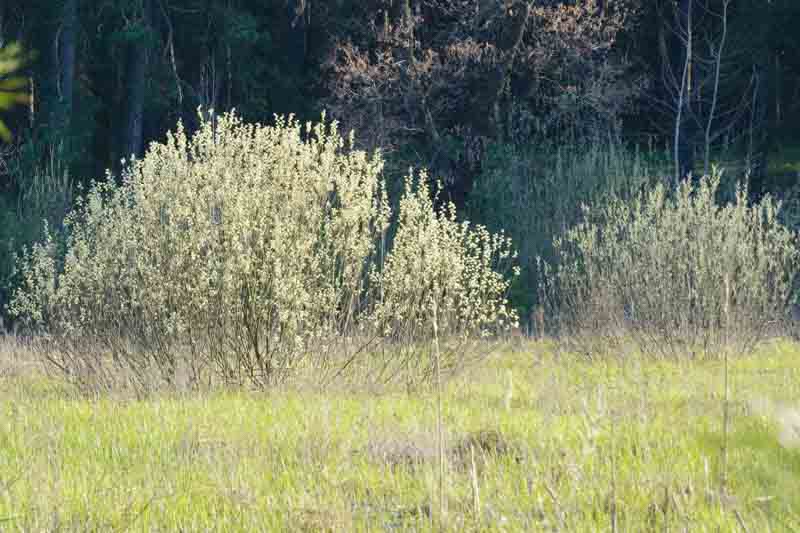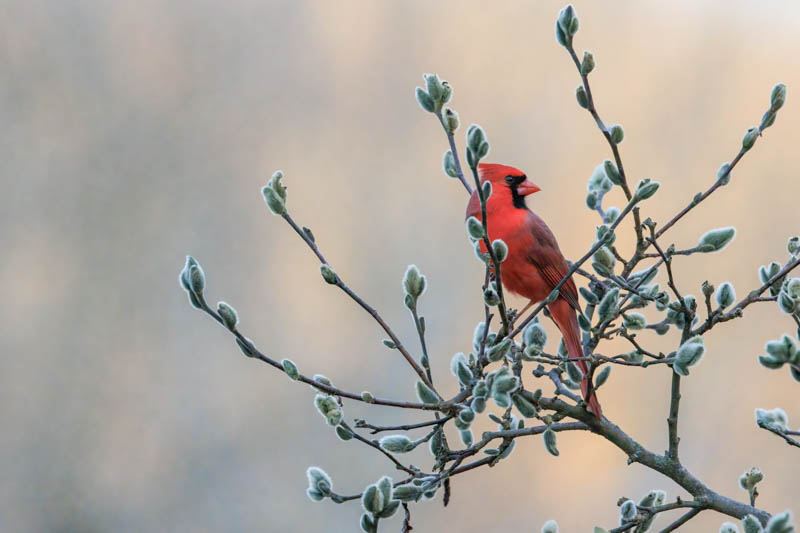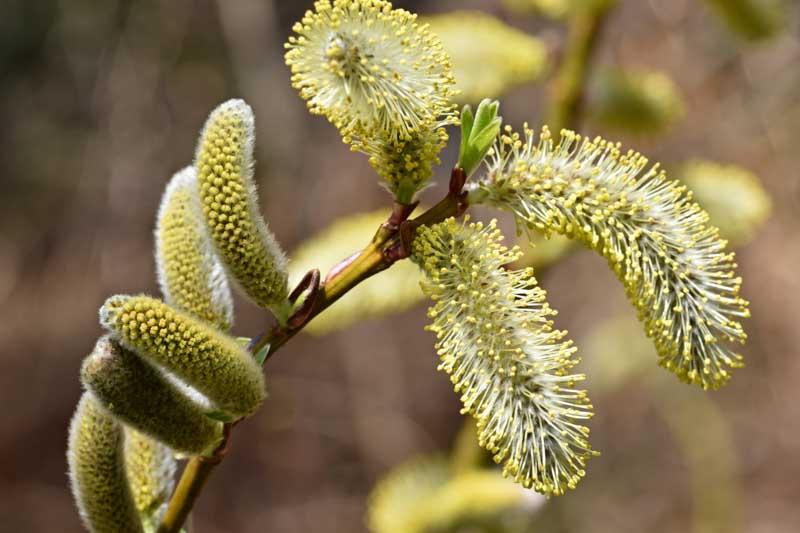Pussy Willow, American Glaucous Willow, American Pussy Willow, Glaucous Willow, Large Pussy Willow
Salix discolor (Pussy Willow) is a striking deciduous shrub or small tree, well-known for its early spring catkins. These fluffy, silver-furred buds precede the leaves, heralding the end of winter.
Native: Native to North America, Salix discolor thrives across Canada and the northeastern United States, favoring wetlands, stream banks, and moist woodlands. Salix shrubs and trees belong to the willow family, Salicaceae.
Plant Type and Habit: Salix discolor is a short-lived, rounded, large shrub or small deciduous tree. Its natural growth pattern is somewhat irregular, contributing to its rustic charm. It has a somewhat open branching structure, with branches starting from the base and spreading outward. This structure supports the dense display of catkins in early spring, providing visual interest even before the leaves appear.
Size: Fast-growing, Salix discolor typically reaches 6 to 15 feet in height (180-450 cm) and 4-12 feet in width (120-360 cm), making it a versatile addition to various garden settings. The plant may be cut to the ground every 3-5 years to keep a smaller shrub size.
Flowers: Salix discolor is dioecious with separate male and female plants. Before the foliage emerges in late winter or early spring, male trees produce a display of silky, pearl gray catkins, 1.5 inches long (3 cm), along their reddish-brown stems. Female trees produce small green catkins. Following the flowers, this willow produces small, capsule-like fruits that split open to release numerous tiny seeds, each adorned with white fluff to aid in wind dispersion.

Foliage: The plant boasts lance-shaped, finely toothed leaves that are dark blue-green on the upper surface and pale to white underneath. In autumn, the foliage turns greenish-yellow, adding seasonal interest.
Bark: The bark is gray and smooth on younger stems, becoming furrowed and darker with age.
Hardiness: It is hardy in USDA zones 4 through 8, tolerating a wide range of climates and conditions.
Uses: Widely used in landscaping for wet areas, erosion control, wildlife gardens, and as a decorative element in early spring bouquets. Pussy Willow can be used as a windbreak and hedge. In early spring, its flowering branches are in high demand.
Wildlife: This willow is among the first flowering plants in the spring, the catkins providing a high quantity of pollen and nectar as a food source to bees and early pollinators. Birds feed on the seeds.
Deer and Rabbit: Salix discolor is somewhat resistant to deer and rabbits, though young plants may need protection in areas where these animals are prevalent.
Toxicity: Generally considered non-toxic to humans and pets.
Invasiveness: It is not typically invasive in its native range, but managing its growth and spread in garden settings is important to prevent unwanted naturalization.
Benefits: Offers significant ecological benefits, including erosion control, habitat creation, and early-season nectar for pollinators, enhancing biodiversity.

Growing and caring for Salix discolor, or American pussy willow is straightforward with these guidelines:
Light: Prefers full sun (6 hours of direct sunlight daily).
Soil: Thrives in a wide range of soil types but prefers fertile, moist, well-drained soils. Tolerant of wet conditions, making it ideal for waterside plantings, this willow also tolerates somewhat drier soils better than most other willows.
Water: Keep soil consistently moist, especially during dry spells and for young plants to establish themselves.
Fertilizer: Pussy willows require minimal fertilization and do well when fed with just compost or leaf mold. You can fertilize them once in the fall with a balanced fertilizer after the plant is over one year old.
Pruning: Prune in late winter or early spring to remove dead or damaged branches and shape the plant. Pruning after flowering allows you to enjoy the catkins before cutting.
Propagation: Easily propagated by cuttings. Take cuttings in late spring or early summer, place in moist soil, and keep well-watered until roots develop.

Pussy willows, like many plants, can be susceptible to a range of pests and diseases. However, with proper care and maintenance, these issues can often be minimized or managed effectively. Here are some common pests and diseases that can affect pussy willows:
Aphids: These small, sap-sucking insects can cluster on new growth and the undersides of leaves, potentially causing leaf distortion and stunted growth.
Borers: Borers are larvae of various insects that tunnel into pussy willow stems and branches, causing wilting and branch dieback. Prevent infestation by maintaining tree health and removing infested wood promptly.
Caterpillars: Caterpillars can defoliate pussy willows, significantly impacting their growth and vigor. Manual removal or the application of Bacillus thuringiensis (Bt) can effectively manage these pests without harming beneficial insects.
Leaf spot: Fungal or bacterial pathogens cause leaf spots, appearing as discolored areas on leaves. Good air circulation, avoiding overhead watering, and removing affected leaves can help manage this issue.
Canker: Cankers are areas of dead bark on branches or stems, often caused by fungal infections. They can girdle and kill branches. Prune out infected parts and avoid wounding the tree to prevent infection.
Powdery mildew: A fungal disease that appears as a white, powdery coating on leaves and stems. It typically doesn’t kill the plant but can reduce its vigor and aesthetic appeal.
Branch Breakage: Due to its rapid growth and sometimes brittle wood, branches may break in high winds or under heavy snow loads.
Suckering: Salix discolor can produce suckers from the base, leading to unwanted spread if not controlled.
Leaf Drop: Stress from drought, poor soil conditions, or disease can cause premature leaf drop.
| Hardiness |
4 - 8 |
|---|---|
| Plant Type | Shrubs, Trees |
| Plant Family | Salicaceae |
| Genus | Salix |
| Common names | Willow, Pussy Willow |
| Exposure | Full Sun |
| Season of Interest |
Spring (Early, Mid, Late) Summer (Early, Mid, Late) Fall Winter |
| Height |
6' - 15' (180cm - 4.6m) |
| Spread |
4' - 12' (120cm - 3.7m) |
| Maintenance | Low |
| Water Needs | Average, High |
| Soil Type | Clay, Loam, Sand |
| Soil pH | Acid, Alkaline, Neutral |
| Soil Drainage | Moist but Well-Drained, Poorly Drained |
| Characteristics | Cut Flowers, Showy |
| Native Plants | United States, Northeast, Pennsylvania, Rhode Island, Vermont, Connecticut, Delaware, Maine, Massachusetts, Maryland, New Hampshire, New Jersey, New York, Ohio, North Dakota, Michigan, Missouri, Minnesota, Midwest, Iowa, Indiana, Illinois, Wisconsin, South Dakota, Southeast, North Carolina, Virginia, West Virginia, Kentucky, Wyoming, Rocky Mountains, Montana |
| Tolerance | Deer, Wet Soil |
| Attracts | Bees, Birds |
| Garden Uses | Hedges And Screens, Ponds And Streams |
| Hardiness |
4 - 8 |
|---|---|
| Plant Type | Shrubs, Trees |
| Plant Family | Salicaceae |
| Genus | Salix |
| Common names | Willow, Pussy Willow |
| Exposure | Full Sun |
| Season of Interest |
Spring (Early, Mid, Late) Summer (Early, Mid, Late) Fall Winter |
| Height |
6' - 15' (180cm - 4.6m) |
| Spread |
4' - 12' (120cm - 3.7m) |
| Maintenance | Low |
| Water Needs | Average, High |
| Soil Type | Clay, Loam, Sand |
| Soil pH | Acid, Alkaline, Neutral |
| Soil Drainage | Moist but Well-Drained, Poorly Drained |
| Characteristics | Cut Flowers, Showy |
| Native Plants | United States, Northeast, Pennsylvania, Rhode Island, Vermont, Connecticut, Delaware, Maine, Massachusetts, Maryland, New Hampshire, New Jersey, New York, Ohio, North Dakota, Michigan, Missouri, Minnesota, Midwest, Iowa, Indiana, Illinois, Wisconsin, South Dakota, Southeast, North Carolina, Virginia, West Virginia, Kentucky, Wyoming, Rocky Mountains, Montana |
| Tolerance | Deer, Wet Soil |
| Attracts | Bees, Birds |
| Garden Uses | Hedges And Screens, Ponds And Streams |
How many Salix discolor (Pussy Willow) do I need for my garden?
| Plant | Quantity | |
|---|---|---|
| Salix discolor (Pussy Willow) | N/A | Buy Plants |
Create a membership account to save your garden designs and to view them on any device.
Becoming a contributing member of Gardenia is easy and can be done in just a few minutes. If you provide us with your name, email address and the payment of a modest $25 annual membership fee, you will become a full member, enabling you to design and save up to 25 of your garden design ideas.
Join now and start creating your dream garden!
Create a membership account to save your garden designs and to view them on any device.
Becoming a contributing member of Gardenia is easy and can be done in just a few minutes. If you provide us with your name, email address and the payment of a modest $25 annual membership fee, you will become a full member, enabling you to design and save up to 25 of your garden design ideas.
Join now and start creating your dream garden!